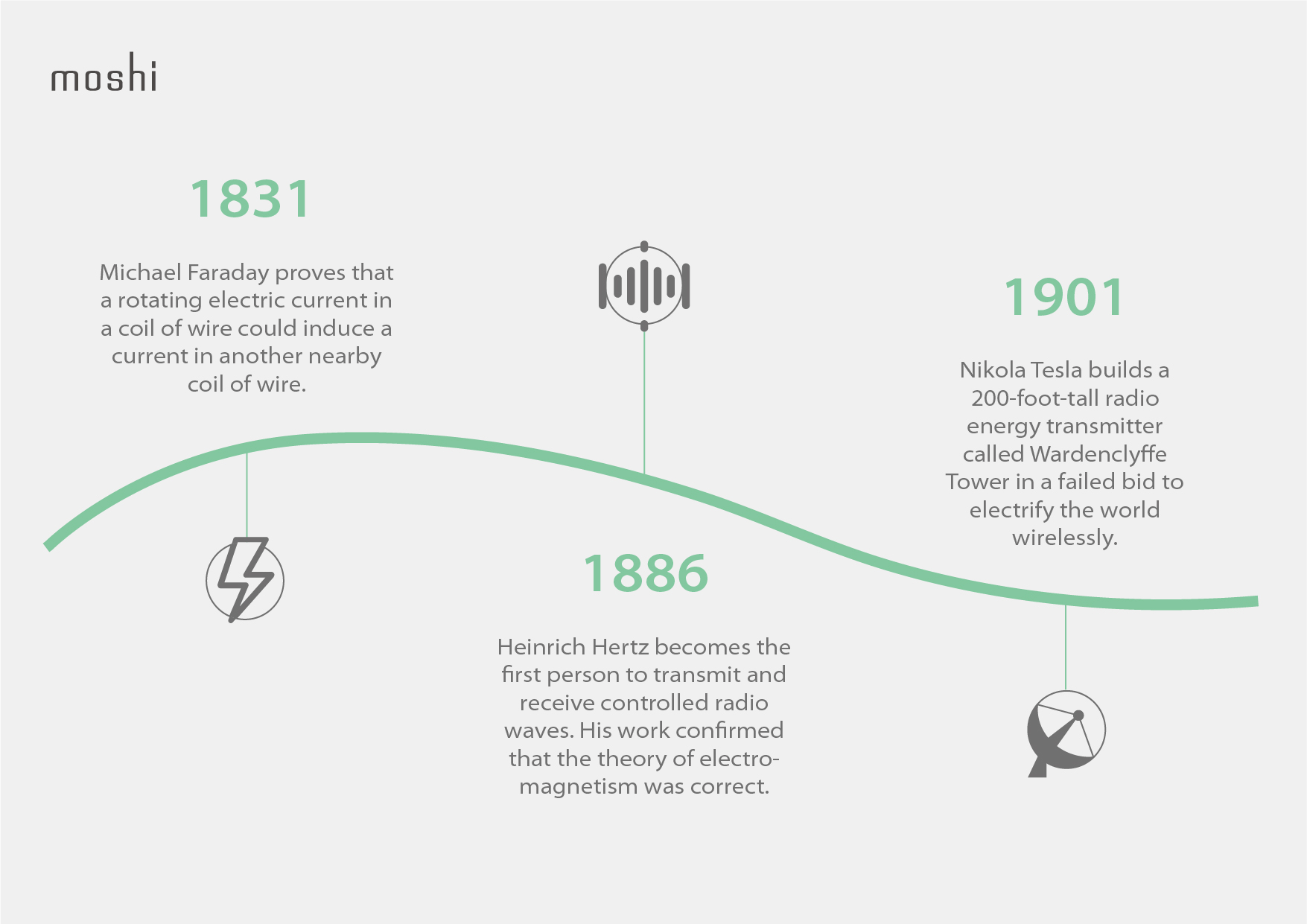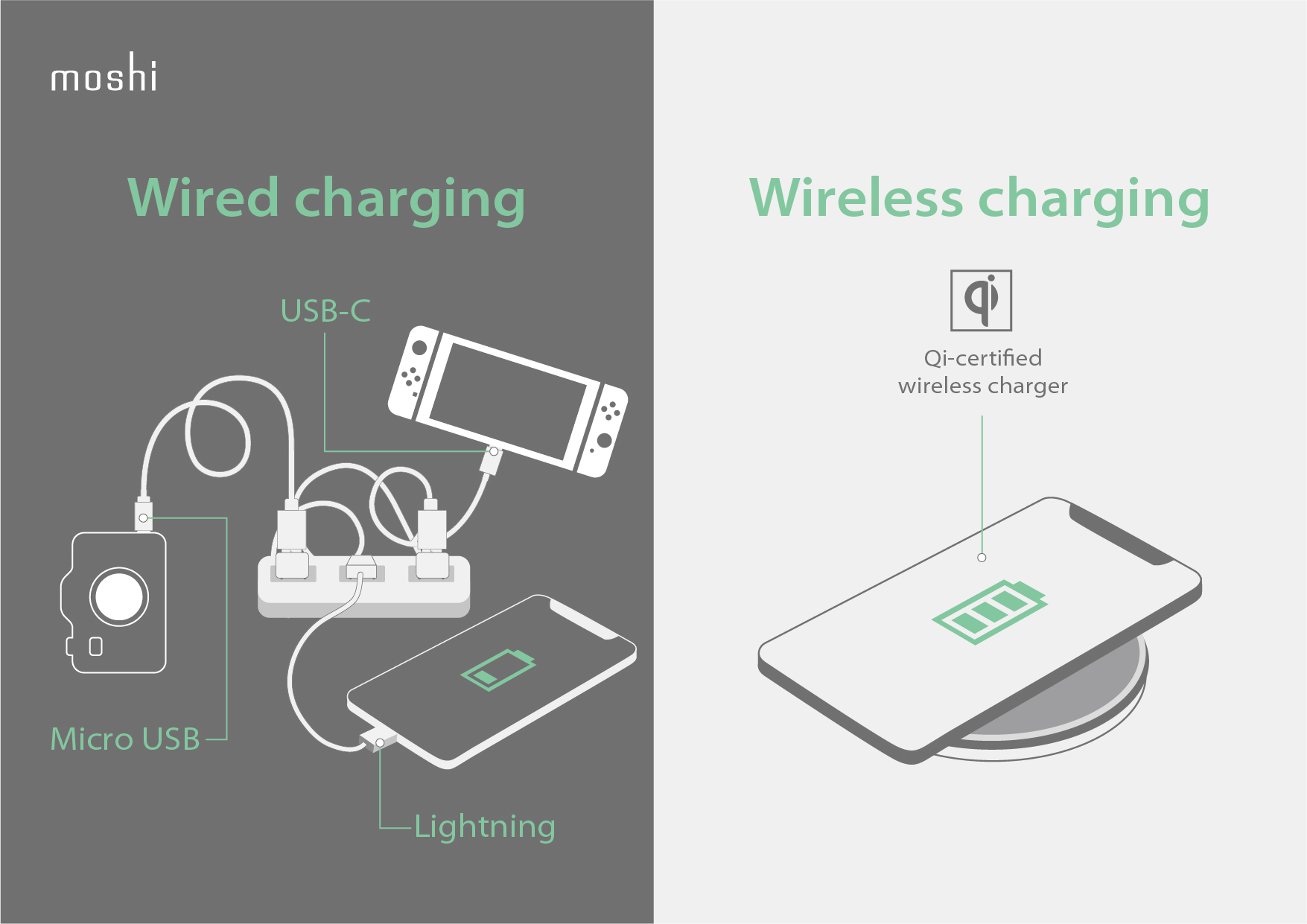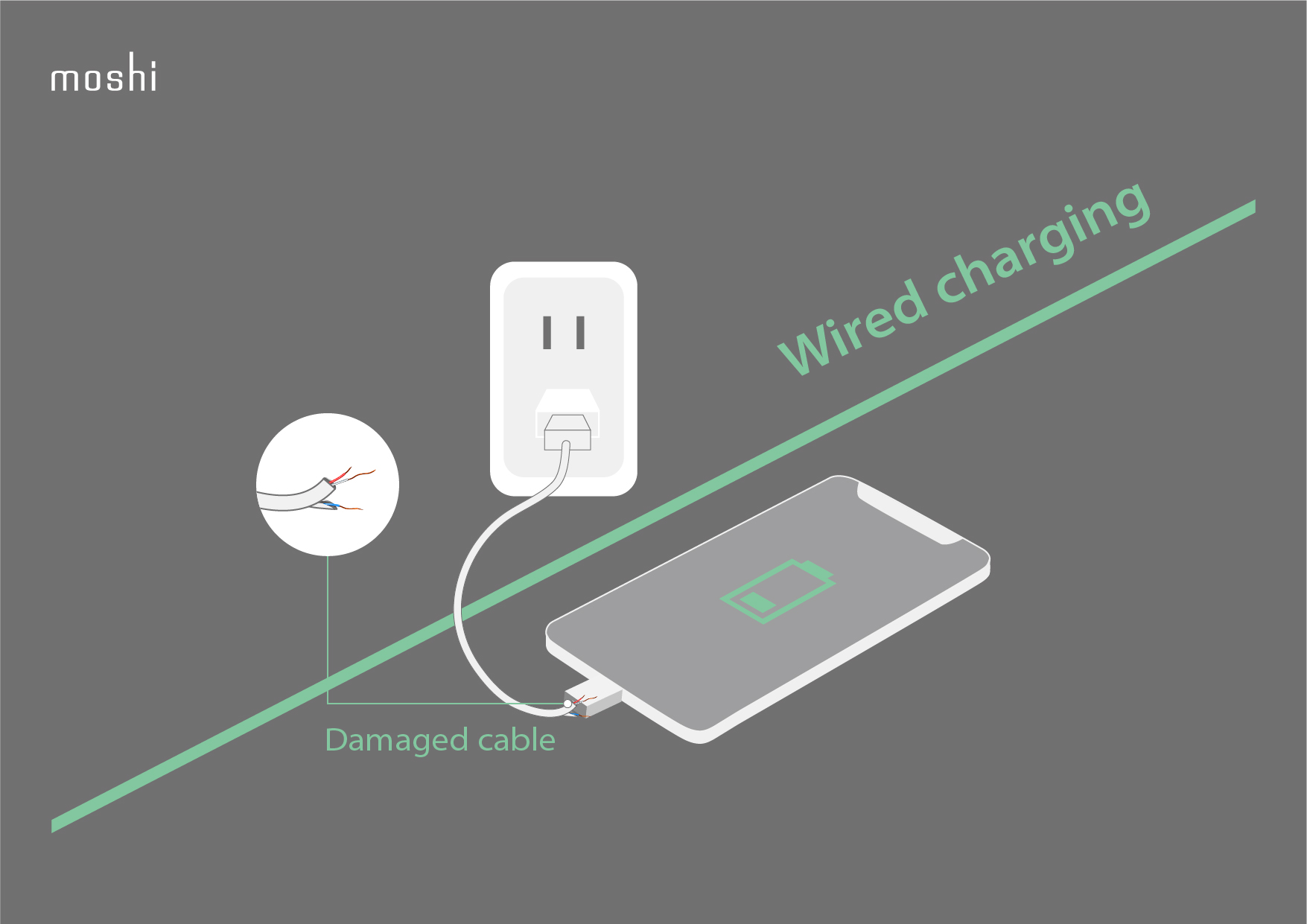The Ultimate Guide to Wireless Charging
When wireless charging first hit mainstream devices around 2012, the media hype was huge. Tech writers promised readers they'd be able to throw out their collections of mismatched cables and adapters. To charge, you'd plop your phone on a table, bowl, or desk as you walked by—like magic.
Although there were still a few kinks to work out, wireless charging technology continued to advance. Today, it's safe to say that convenient and efficient wireless charging has arrived—and it just keeps getting better.
Was the initial hype surrounding the technology warranted? As more consumers discover the ease and simplicity of wireless charging, it looks like the answer is yes.
History of wireless inductive charging
The desire to go wireless isn't new. People have been trying to transmit power without wires as long as there have been practical applications for it.
Here's a brief timeline of the early years of wireless power transmission:

Despite this progress, significant barriers to efficient wireless transmission remained. With few practical applications to be found, the technology crawled forward over the next 100 years. But the mobile device boom at the beginning of the 21st Century created a big incentive for researchers to revisit wireless charging.
This massive new market for wireless charging spurred progress, but it also created conflict—and headaches for consumers. For several years starting in 2006, different wireless charging standards competed for dominance.
These included the Powermat standard (adopted by heavy hitters like General Motors, Starbucks, and Delta Airlines) and the Wireless Power Consortium's (WPC's) Qi standard (first backed by tech powerhouses like Samsung, Google, and Verizon).
During this period, wireless charging fell short of its promise to make mobile devices easier to use. Most smartphone brands supported only one wireless charging standard (with the notable exception of Samsung). This often left consumers unable to use wireless charging stations without an adaptive case for their device.
By 2018, the Qi standard had won out. Apple's iPhone 8 family was the first generation of Apple phones to support wireless charging, and the rest is history. Powermat's entry into the WPC and the widespread adoption of the Qi standard ended the wireless charging wars.
Finally, wireless charging became practical thanks to everyone following a single standard.
Today, almost every wireless charger uses Qi, and most mobile devices support Qi wireless charging. The glass backs found on many new smartphones reflect the enormous demand for wireless charging (metal backs interfere with charging efficiency).
In the future, we can expect wireless charging to move well beyond smartphones. Before long, laptops, kitchen appliances, and even electric cars may all be capable of wireless charging.
"Today, almost every wireless charger uses Qi, and most mobile devices support Qi wireless charging."
How does wireless charging work?
Wireless charging works off the principle of electromagnetic induction. It's the same principle behind those induction stoves that have been around for years.
Both the charger and the receiving device contain wireless charging coils. The transmitting coil is located in the charging pad. The receiving coil is situated at the back of the phone and connected to the battery.
The transmitting coil converts electricity and emits an alternating electromagnetic field. When the receiving coil is within this field, it turns the energy into an electric current that is sent to the battery.

The evolution of Qi
The Qi standard (pronounced "chee") is named after the Chinese concept of the flow of vital energy through every living thing.
Set by the WPC, the Qi standard defines various power specifications that correspond to how much energy flows between charger and device. Qi also includes a data transfer spec which lets the device request the optimal amount of power from the wireless charger.

The Baseline Power Profile (BPP) specification supports up to 5 W of power output. The Extended Power Profile (EPP) specification supports up to 15 W. Both BPP and EPP are used to charge mobile devices, but EPP is more advanced thanks to its fast-charging support. For a more in-depth explainer, check out our blog article.
The Qi standard also includes a Medium power spec that currently delivers 30-65 W (it's expected to eventually support up to 200 W). This spec is used for larger devices like kitchen appliances, robotic vacuum cleaners, power tools, and drones.

Fast-charging with Qi
The difference between BPP and EPP may seem technical, but it has a significant impact on your wireless charging experience. All wireless charging products for mobile devices use either BPP (5 W maximum) or EPP (15 W maximum), and you might think that since EPP chargers can output more power, buying an EPP charger will automatically lead to faster charging. But that's not necessarily the case.
Your mobile device's ability to receive power is the limiting factor when it comes to charging speed. Your device must be able to receive 7 W of power to be capable of fast wireless charging, no matter what kind of charger you use.
Your phone's ability to receive power output is predetermined by the manufacturer. Here are the specs for a few major brands:
- Apple: 7.5 W
- Sony: 11 W
- LG: 10 W
- Google: 12 W*
- Samsung: 9 W**
*12 W charging for Pixel 5 devices
** Samsung requires that wireless chargers pass the additional Samsung Proprietary Power Delivery Extension (PPDE) certification in order to deliver power above 5 W. EPP chargers not certified under this extension will only charge at BPP wattage when used with Samsung phones. Read more about Samsung phones which support Qi wireless charging.
"Your device must be able to receive 7 W of power to be capable of fast wireless charging, no matter what kind of charger you use."
Even if your phone and charger both support fast wireless charging, choosing the wrong accessories can still slow you down. Both your cable and wall adapter must be able to receive enough power to be capable of fast charging. For example, if you own a 10 W charging pad plugged into a 5 W wall charger, your device will only charge at 5 W so you won't get the benefits of fast charging.
Make sure your device, cable, and wall charger all support enough power to enable fast wireless charging. Here's an example of a setup that will work:
- USB-C Wall Charger (10 W)
- USB-C to USB-C cable
- Charging pad (10 W)
What are the key advantages of wireless charging?
Less clutter
The main benefit of wireless charging is right there in the name—wireless. Wireless charging cuts down on clutter from charging cables. The only cable you'll need is the charging pad's power cable.

Easier charging
Wireless charging also eliminates the need to plug a cable into your phone. Ever plugged your phone in and discovered hours later that the cable connection wasn't secure—and your phone is still dead? Wireless charging eliminates that problem. Just place your phone on your charging pad, and it'll start charging right away.
Longer device life
No repeated cable plugging and pulling means less wear and tear on your phone's charging port. Since the charging port is a common point of failure for mobile devices, your phone may even last longer.
No cable compatibility issues
No charging cables also means you can say goodbye to that timeless problem among tech enthusiasts—mismatched connectors. No need to worry about not having a Lightning, USB-C, or Micro USB cable on hand anymore. All Qi devices work on all Qi charging pads.
Less e-waste
The benefits of reducing e-clutter go far beyond your personal tidiness. The current lack of a common wired charging standard leads to an enormous amount of unnecessary e-waste. The widespread adoption of wireless charging could help solve this problem.
Currently, most Android devices use USB-C ports, while Apple devices use the Lightning connector exclusively. That means that to switch from Android to Apple or vice versa, you need to get new charging cables (and maybe new adapters). Unfortunately, your old cables and adapters are very likely to end up in a landfill.
Charging cables may be small, but the e-waste problem isn't.

In January 2020, the European Parliament voted for new regulations to establish a universal charging standard for phone manufacturers in the European Union. The EU claims that agreeing on a shared charger standard will put an end to charger clutter and 50 million metric tonnes of e-waste annually (16.6 kg per inhabitant).
Wireless charging is ahead of the game when it comes to reducing e-waste. Qi wireless charging has already achieved a universal charging standard. Apple, Android, and Google all support the Qi standard, making it the most reliable charging standard today.
Safer charging products
As more users adopt wireless charging, additional benefits of standardized chargers will become clear. The quality of charging products on the market should go up, with fewer counterfeit chargers being sold. That will guarantee a higher level of safety for users worldwide.
6 myths about wireless charging
Despite its advancements, there are still many people with concerns about wireless charging. Most of these worries are holdovers from the old days of wireless charging when the standards weren't quite as refined.
Here are some of the most common myths and misconceptions busted.
1. Wireless charging is slow
This misconception may date back to wireless charging's 5 W days. It definitely was slow back then. But today's fast wireless charging pads can provide 10 or even 15 W of power, which is as fast or even faster than wired charging.
2. Wireless charging is inefficient
The conversion from electric current to electromagnetic field and back doesn't cause significant efficiency losses. You can recover as much as 80% of the input wattage when charging wirelessly, but make sure your wireless charger features an efficient coil design. Cheap uncertified wireless chargers tend to use inferior materials and components which can affect efficiency.
3. Wireless charging is dangerous
Some people think the energy transmitted wirelessly could be hazardous to your body. However, magnetic induction only works across very short distances. At a distance of only 4 cm, you're totally safe from any potential effects of the radiation, and charging pads do not emit electromagnetic radiation constantly. Qi-certified chargers won't produce a magnetic charging field unless a phone is on the pad.

4. Wireless charging can overheat your phone's battery
All charging (both wired and wireless) generates some heat, but solid electrical engineering can keep heat levels low enough to prevent battery damage. That's why it's essential to buy wireless chargers from a reputable brand. Learn why Moshi’s Q-coil technology keeps your device cool and was rated “the fastest wireless charger” in the world.

5. Frequent wireless charging degrades your phone's battery life
Charging in general doesn’t have an impact on battery life, and wireless charging may actually be safer than certain fast-charging cables. Qi wireless chargers use a lower current compared to wired charging, which creates a more stable charging scenario. Wireless chargers also make it easy to top off your battery throughout the day. By setting your phone on a nearby charging pad when not in use, you can prevent the battery from dropping below 50%, which may increase the overall lifespan of your battery.


6. Overnight wireless charging can damage your phone
For many people, overnight is the most convenient time to charge. However, some worry that charging while you sleep can lead to overcharging and potential battery damage. Luckily, this isn't something we need to be concerned about. Smartphone batteries have a charge control system that disconnects the battery from the charger as soon as the battery is 100% charged. No matter how long the phone sits on the charger, it stays at the cut-off of the charging current with no risk of overcharging. That applies to both wireless and wired charging.
The future of wireless charging
Wireless charging has a bold, bright future ahead of it. More and more manufacturers are including Qi support in their phones, and peripheral manufacturers are adding Qi charging to more devices.
Wirelessly charging your smartphone will probably get even easier as charging technology advances. Manufacturers like Google and Samsung now support reverse wireless charging on some models, which allows phones to wirelessly charge other phones and smaller devices such as earbuds.
The charging pad itself could be getting a makeover. Some devices like monitors and mouse pads now include integrated wireless charging. New accessories like Moshi’s SnapTo Series feature wireless charging built directly into the mount. Even furniture makers are getting in on the action by creating Qi-enabled tables and desks. That's precisely the kind of innovation that got people so excited about wireless charging when it first hit the scene.
Wondering when larger devices will cut the cord? It's already happening.
In June 2017, Dell launched the world's first laptop that can charge wirelessly using magnetic resonance charging technology. You can expect to see more manufacturers rolling out wireless charging-enabled laptops over the next few years.
Tired of trying to find counter space near an outlet for your Instant Pot, rice cooker, or food processor? Soon you won't need to. The WPC's upcoming Ki Cordless Kitchen standard will deliver up to 2200 W to kitchen appliances wirelessly.

When it comes to wireless charging, the future has finally arrived. There's never been a better time to adopt this promising technology.
Learn more: Q-coil Technology
Moshi’s Q-coil wireless charging module features a multilayer heat sink design for enhanced passive cooling. Unlike cheap wireless chargers made with entry-level components, Q-coil chargers stay cool even while fast-charging.

These are some of the high-quality components and materials that make this possible:
- Our charging coil module uses high-purity copper wire and a high quality ferrite sheet to improve charging efficiency and reduce temperature.
- Low-resistance DC/DC power converters improve conversion efficiency and regulate the circuit board's temperature.
- A special multilayer heat sink dissipates the charger's thermal energy downwards, reducing heat transfer between the charger and the phone.
- Built-in over-voltage, over-current, and over-temperature protection circuits make the charging process safer.
- Qi certification ensures charging compatibility, reliability and safety.
Learn more about the Qi wireless charging specification with our handy guide to Qi EPP, or check out our Q Collection Qi-certified wireless chargers.
Sample Block Quote
Praesent vestibulum congue tellus at fringilla. Curabitur vitae semper sem, eu convallis est. Cras felis nunc commodo loremous convallis vitae interdum non nisl. Maecenas ac est sit amet augue pharetra convallis nec danos.
Sample Paragraph Text
Praesent vestibulum congue tellus at fringilla. Curabitur vitae semper sem, eu convallis est. Cras felis nunc commodo eu convallis vitae interdum non nisl. Maecenas ac est sit amet augue pharetra convallis nec danos dui.
Cras suscipit quam et turpis eleifend vitae malesuada magna congue. Damus id ullamcorper neque. Sed vitae mi a mi pretium aliquet ac sed elitos. Pellentesque nulla eros accumsan quis justo at tincidunt lobortis denimes loremous. Suspendisse vestibulum lectus in lectus volutpat, ut dapibus purus pulvinar. Vestibulum sit amet auctor ipsum.










ווינר אונליין
https://win-line.net/ווינר-ליין-ווינר-אונליין/
לשלוח, תימוכין לדבריך.
הקזינו באינטרנט הפכה לענף נחשק מאוד בשנים האחרונות, המציע אפשרויות שונות של חלופות הימורים, כגון הימורי ספורט.
בסקירה זה נבחן את עולם ההתמודדות המקוונת ונמסור לכם מידע חשוב שיתרום לכם לנתח בנושא אטרקטיבי זה.
הימורי ספורט – הימורים באינטרנט
הימורי ספורט מציע מבחר מגוון של משחקים מסורתיים כגון חריצים. הקזינו באינטרנט מספקים למבקרים להשתתף מאווירת התמודדות מקורית בכל עת ומקום.
המשחקים תיאור קצר
מכונות שלוט משחקי מזל עם גלגלים
הימורי רולטה הימור על תוצאות על גלגל מסתובב בצורה עגולה
משחק קלפים להגעה ל-21 משחק קלפים בו המטרה היא 21 נקודות
פוקר משחק קלפים מורכב
התמודדות בבאקרה משחק קלפים מהיר וקצר
הימורים על אירועי ספורט – קזינו באינטרנט
הימורים בתחום הספורט מהווים אחד הסגמנטים המתפתחים המרכזיים ביותר בפעילות באינטרנט. משתתפים מסוגלים להתמודד על תוצאים של אתגרי ספורט מועדפים כגון כדורסל.
העסקאות ניתן לתמוך על תוצאת התחרות, מספר הנקודות ועוד.
סוג ההימור הסבר תחומי ספורט מובילים
ניחוש הביצועים ניחוש התוצאה הסופית של האירוע כדורגל, כדורסל, קריקט
הפרש ביצועים ניחוש הפרש הנקודות בין הקבוצות כל ענפי הספורט
כמות הסקורים ניחוש כמות הסקורים בתחרות כדורגל, כדורסל, קריקט
הקבוצה המנצחת ניחוש מי יזכה בתחרות (ללא קשר לביצועים) מרבית ענפי הספורט
הימורי חי הימורים במהלך המשחק בזמן אמת מגוון ענפי ספורט
התמודדות מורכבת שילוב של מספר סוגי התמרמרות מרבית ענפי הספורט
פוקר אונליין – פעילות באינטרנט
פוקר אונליין מכיל אחד מענפי הפעילות הפופולריים המובהקים ביותר בתקופה הנוכחית. מתמודדים מורשים להשתלב בפני שחקנים אחרים מכל רחבי העולם במגוון
פוקר אונליין
https://win-line.net/פוקר-אונליין-באינטרנט-על-כסף-אמיתי/
לבצע, נתונים לדבריך.
הקזינו באינטרנט הפכה לתחום מבוקש מאוד לאחרונה, המאפשר אפשרויות מגוונות של אפשרויות התמודדות, כמו מכונות מזל.
בסקירה זה נסקור את תעשיית ההימורים המקוונים ונעניק לכם נתונים חשובים שיעזור לכם להבין בנושא מסקרן זה.
הימורי ספורט – התמודדות באינטרנט
קזינו אונליין מכיל אופציות שונות של אירועים מוכרים כגון בלאק ג’ק. הקזינו באינטרנט מספקים לשחקנים לחוות מחוויית התמודדות מקורית בכל מקום ובשעה.
האירוע תיאור קצר
משחקי מזל משחקי מזל עם גלגלים
גלגל הרולטה הימור על מספרים וצבעים על גלגל הרולטה
משחק הקלפים בלאק ג’ק משחק קלפים בו המטרה להגיע לסכום של 21
פוקר משחק קלפים מבוסס אסטרטגיה
משחק הבאקרה משחק קלפים פשוט ומהיר
הימורים על אירועי ספורט – פעילות באינטרנט
התמרמרות ספורטיבית מייצגים אחד הסגמנטים המתפתחים המובילים ביותר בקזינו באינטרנט. שחקנים מסוגלים להשקיע על תוצאים של משחקי ספורט פופולריים כגון טניס.
השקעות אפשר לבצע על הביצועים בתחרות, מספר הנקודות ועוד.
אופן ההתמודדות ניתוח משחקי ספורט מרכזיים
ניחוש הביצועים ניחוש התוצאה הסופית של האירוע כדורגל, כדורסל, אמריקאי
הפרש ביצועים ניחוש ההפרש בביצועים בין הקבוצות כדורגל, כדורסל, הוקי
כמות הסקורים ניחוש כמות הביצועים בתחרות כדורגל, כדורסל, קריקט
הקבוצה המנצחת ניחוש איזו קבוצה תנצח (ללא קשר לתוצאה) מספר ענפי ספורט
הימורי חי הימורים במהלך האירוע בזמן אמת מגוון ענפי ספורט
פעילות מעורבת שילוב של מספר פעילויות מרבית ענפי הספורט
משחקי קלפים אונליין – פעילות באינטרנט
משחקי קלפים אונליין מייצג אחד מסוגי הקזינו המשגשגים ביותר בתקופה הנוכחית. מתמודדים רשאים להשתתף כנגד מתמודדים אחרים מכל רחבי הכדור הארצי במגוון
סוכן קזינו
https://win-line.net/סוכן-קזינו-הימורים/
להגיש, אסמכתא לדבריך.
ההתמודדות באינטרנט הפכה לתעשייה מבוקש מאוד בשנים האחרונות, המכיל מבחר רחב של אלטרנטיבות פעילות, לדוגמה מכונות מזל.
בסיכום זה נבדוק את תחום הקזינו המקוון ונייעץ לכם פרטים חשובים שיסייע לכם להבין באזור מרתק זה.
משחקי פוקר – קזינו באינטרנט
משחקי פוקר מכיל מבחר מגוון של אירועים ידועים כגון חריצים. הפעילות באינטרנט מאפשרים לשחקנים ליהנות מאווירת הימורים מקצועית בכל מקום ובשעה.
סוג המשחק פירוט קצר
מכונות פירות הימורים עם גלגלים
הימורי רולטה הימור על מספרים ואפשרויות על גלגל הרולטה
משחק הקלפים בלאק ג’ק משחק קלפים להשגת ניקוד של 21
משחק קלפים פוקר התמודדות אסטרטגית בקלפים
באקרה משחק קלפים קל וזריז
הימורים בתחום הספורט – הימורים באינטרנט
הימורי ספורט הם אחד הסגמנטים הצומחים המרכזיים ביותר בהימורים באינטרנט. שחקנים מורשים להשקיע על תוצאים של משחקי ספורט מועדפים כגון טניס.
התמודדויות אפשר לבצע על תוצאת המשחק, מספר האירועים ועוד.
אופן ההתמודדות תיאור משחקי ספורט מרכזיים
ניחוש הביצועים ניחוש הביצועים הסופיים בתחרות כדורגל, כדורסל, הוקי
הפרש סקורים ניחוש ההפרש בתוצאות בין הקבוצות כל ענפי הספורט
מספר שערים/נקודות ניחוש כמות הביצועים בתחרות כדורגל, כדורסל, קריקט
הצד המנצח ניחוש מי יהיה הזוכה (ללא קשר לתוצאה) מרבית ענפי הספורט
התמרמרות בזמן אמת התמודדות במהלך האירוע בזמן אמת כדורגל, טניס, קריקט
הימורים משולבים שילוב של מספר הימורים שונים מספר ענפי ספורט
התמודדות בפוקר מקוון – קזינו באינטרנט
משחקי קלפים אונליין מהווה אחד מסוגי ההימורים המרכזיים המובהקים ביותר בתקופה הנוכחית. שחקנים מורשים להתמודד מול מתמודדים אחרים מאזורי הגלובליזציה בסוגים ש
娛樂城
台灣線上娛樂城是指通過互聯網提供賭博和娛樂服務的平台。這些平台主要針對台灣用戶,但實際上可能在境外運營。以下是一些關於台灣線上娛樂城的重要信息:
1. 服務內容:
- 線上賭場遊戲(如老虎機、撲克、輪盤等)
- 體育博彩
- 彩票遊戲
- 真人荷官遊戲
2. 特點:
- 全天候24小時提供服務
- 可通過電腦或移動設備訪問
- 常提供優惠活動和獎金來吸引玩家
3. 支付方式:
- 常見支付方式包括銀行轉賬、電子錢包等
- 部分平台可能接受加密貨幣
4. 法律狀況:
- 在台灣,線上賭博通常是非法的
- 許多線上娛樂城實際上是在國外註冊運營
5. 風險:
- 由於缺乏有效監管,玩家可能面臨財務風險
- 存在詐騙和不公平遊戲的可能性
- 可能導致賭博成癮問題
6. 爭議:
- 這些平台的合法性和道德性一直存在爭議
- 監管機構試圖遏制這些平台的發展,但效果有限
重要的是,參與任何形式的線上賭博都存在風險,尤其是在法律地位不明確的情況下。建議公眾謹慎對待,並了解相關法律和潛在風險。
如果您想了解更多具體方面,例如如何識別和避免相關風險,我可以提供更多信息。
Коммерческий секс в российской столице существует как комплексной и многоаспектной вопросом. Несмотря на данная деятельность запрещается юридически, этот бизнес остаётся значительным подпольным сектором.
Прошлый
В Союзные периоды коммерческий секс существовала в тени. По окончании Советского Союза, в ситуации экономической нестабильности, секс-работа стала быть явной.
Современная обстановка
Сейчас интимные услуги в столице представляет собой многочисленные формы, начиная с высококлассных услуг эскорта и заканчивая публичной проституции. Престижные обслуживание обычно осуществляются через сеть, а на улице коммерческий секс располагается в выделенных районах столицы.
Социальные и экономические факторы
Множество женщин вступают в данную сферу по причине материальных проблем. Проституция может оказаться интересной из-за возможности мгновенного заработка, но это влечет за собой вред для здоровья и безопасности.
Юридические аспекты
Интимные услуги в Российской Федерации не законна, и за её занятие состоят серьезные штрафы. Секс-работниц часто привлекают к юридической вине.
Таким способом, не обращая внимания на запреты, проституция остаётся элементом экономики в тени города с существенными социальными и юридическими последствиями.
дешевые проститутки алтуфьево